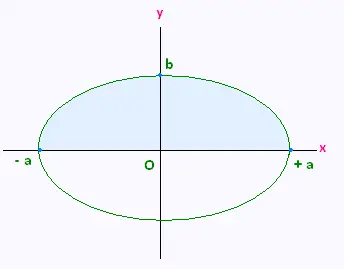Astronomie:
Compléments de Mathématiques
Aire d'une ellipse
Aire d'une ellipse

L'équation de l'ellipse en coordonnées cartésiennes s'écrit:
\begin{equation}
\dfrac{y^2}{b^2} = 1- \dfrac{x^2}{a^2}
\end{equation}
On forme la fonction suivante:
\begin{equation}
y = f(x) = b\sqrt{1- \dfrac{x^2}{a^2}}
\end{equation}
On calcule la moitié de l'aire de l'ellipse:
\begin{equation}
\bf{\color{green}{
\frac{\mathcal{A}}{2} = \int_{-a}^a {f(x) dx } = \int_{-a}^a{b\sqrt{1- \dfrac{x^2}{a^2}}} dx
} }
\end{equation}
On fait le changemenet de variable suivant:
\begin{equation}
\bf{\color{blue}{
x = a cos \theta \;\text{ donc }\; dx = - a sin \theta d\theta
} }
\end{equation}
L'aire de la demi-ellipse devient
\begin{equation}
\bf{\color{green}{
\frac{\mathcal{A}}{2} = \int_{-a}^a {b\sqrt{1- \dfrac{x^2}{a^2}}} \; dx =
\\
ab \int_{\pi}^0{\sqrt{1 - cos^2\theta}} \; (- sin\theta) d\theta =
\\
- ab \int_{\pi}^0{sin^2 \theta} d\theta =
} }
\end{equation}
On sait que:
\begin{equation}
\bf{\color{red}{
sin^2 \theta = \dfrac{1 - cos 2\theta}{2}
} }
\end{equation}
L'intégrale devient:
\begin{equation}
\bf{\color{green}{
\frac{\mathcal{A}}{2} =
ab \int_0^{\pi}\dfrac{1 - cos 2 \theta}{2} d\theta =
ab\left[\dfrac{\theta}{2} - \dfrac{sin(2\theta)}{4} \right]_0^{\pi} =
\dfrac{\pi a b }{2}
} }
\end{equation}
soit
\begin{equation} \Large{\color{brown}{
\mathcal{A} = \pi\,a\,b. \;
} }
\end{equation}
|